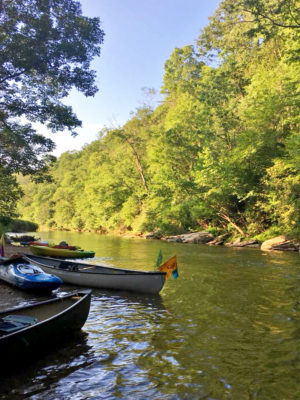
Spectators watch as a kayaker plummets through the Green River Narrows during the annual Green Race. Photo by Serge Skiba
The Green is located near Saluda, N.C., in Polk and Henderson counties.
How to access: The gorge has three sections — the Lower Green, the Upper Green and the Narrows. There are specific put-in and take-out spots for each section, and visitors should be aware of which section they are entering, as they differ drastically in difficulty. Some of the take-outs involve a hike and require visitors to gain permission to access specific parking lots. For directions and guidelines, search Green River, N.C., on the
American Whitewater website.
Difficulty: The Lower Green is the easiest and is popular for tubing, ranging from Class I to II, while the Upper Green contains more adventurous whitewater ranging from Class II to IV. The Narrows is for experienced whitewater kayakers at Class IV to V, and two drops at V+.
Fun facts: The Green River Narrows hosts the iconic annual Green Race on the first Saturday of November. The race is going on its 24th year and attracts more than 100 racers and thousands of spectators annually.
Local Champion: The Green Riverkeeper is the protector and watchdog of the Green River Basin. This role is filled by Gray Jernigan, who is also the Southern Regional Director of the nonprofit environmental group MountainTrue. His work includes identifying sources of pollution, upholding environmental laws and facilitating restoration projects. To learn more or get involved, visit
mountaintrue.org/green-riverkeeper
More info: H2o Dreams is an outfitter that provides instruction for all three sections so visitors of any skill level can experience the Green. Visit their webpage at
h2odreams.com. For directions and other resources on the Green, visit
romanticasheville.com/green-river-gorge. — Sam Kepple

Paying tribute to Lenny Kohm on the South Fork of the New River. Photo by Jamie Goodman
The New River flows north from North Carolina and passes through Virginia before joining the Gauley River in West Virginia to form the Kanawha River. In North Carolina, the New has two forks: the North Fork and the South Fork.
How to access: North Carolina’s New River State Park has three major access points on the South Fork in Ashe and Alleghany counties: Wagoner Access, U.S. 221 Access and King’s Creek Access. There are other public access points beyond the state park boundaries, and several outfitters offer shuttle services to take boaters to more remote, private access points.
Difficulty: The South Fork is considered a family-friendly river, and is also suitable for tubing. There are a few sets of rapids that are relatively easy to navigate, ranked as Class I or Class II depending on water levels. For a shorter trip that avoids rapids altogether, outfitters can help with planning or provide tube or boat rentals for a flatwater trip.
Fun Facts: While it is unknown just how old the New River is, many scientists believe it to be one of the oldest rivers in the world due to the way it formed and how it contorts around mountains. In some places, the river has exposed rocks that are more than a billion years old.
Local Champion: The New River Conservancy is a nonprofit organization based in West Jefferson, N.C., that aims to protect the waters, woodlands and wildlife of the New River watershed. To learn more or participate in projects such as river cleanups, visit
newriverconservancy.org
More info: Staff at the New River State Park can provide maps and directions to access points or recommend a rental outfitter that best meets your needs. Maps are also available at
ncparks.gov/new-river-state-park. — Sam Kepple
